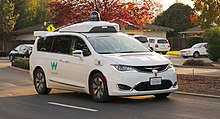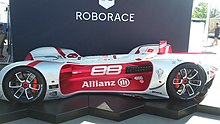| Part of a series on |
| Self-driving cars & self-driving vehicles |
|---|
 |
| Enablers |
| Topics |
| Related topics |
A self-driving car, also known as an autonomous car (AC), driverless car, or robotic car (robo-car),[1][2][3] is a car that is capable of traveling without human input.[4][5] Self-driving cars are responsible for perceiving the environment, monitoring important systems, and control, including navigation.[6] Perception accepts visual and audio data from outside and inside the car and interpret the input to abstractly render the vehicle and its surroundings. The control system then takes actions to move the vehicle, considering the route, road conditions, traffic controls, and obstacles.[7][8][9][10][11]
They have the potential to impact the automotive industry, health, welfare, urban planning, traffic, insurance, labor market, and other domains. Appropriate regulations are necessary for deployment.
Autonomous ground vehicle capabilities can be categorized in six levels[12] defined by SAE International (SAE J3016).[13]
As of August 2023, no system had reached the highest level, although multiple vendors are pursuing autonomy. Waymo was the first to offer robo taxi rides to the general public, and offers services in various US cities, followed by Cruise, in San Francisco.[14] Honda was the first manufacturer to sell a Level 3 car,[15][16][17] followed by Mercedes-Benz.[18], BMW Group and Kia. Nuro offers autonomous commercial delivery operations in California.[19] DeepRoute.ai launched a robotaxi service in Shenzhen.[20] Palo Alto, California certified Nuro at Level 4.[21]
 Waymo undergoing testing in the San Francisco Bay Area Waymo undergoing testing in the San Francisco Bay Area |  Roborace autonomous racing car on display at the 2017 New York City ePrix Roborace autonomous racing car on display at the 2017 New York City ePrix |
History
Experiments have been conducted on automated driver assistance systems (ADAS) since at least the 1920s;[22] trials began in the 1950s. The first semi-autonomous car was developed in 1977, by Japan's Tsukuba Mechanical Engineering Laboratory.[23] It required specially marked streets that were interpreted by two cameras on the vehicle and an analog computer. The vehicle reached speeds of 30 km/h (19 mph) with the support of an elevated rail.[24][25]
Carnegie Mellon University's Navlab[26] and ALV[27][28] semi-autonomous projects appeared in the 1980s, funded by the United States' Defense Advanced Research Projects Agency (DARPA) starting in 1984 and Mercedes-Benz and Bundeswehr University Munich's EUREKA Prometheus Project in 1987.[29] By 1985, ALV had reached 31 km/h (19 mph), on two-lane roads. Obstacle avoidance came in 1986, and day and night off-road by 1987.[30] In 1995 Navlab 5 completed the first autonomous US coast-to-coast. Traveling from Pittsburgh, Pennsylvania and San Diego, California, 98.2% were autonomous, completed with an average speed of 63.8 mph (102.7 km/h).[31][32][33][34] Until the second DARPA Grand Challenge in 2005, automated vehicle research in the United States was primarily funded by DARPA, the US Army, and the US Navy, yielding incremental advances in speeds, driving competence, controls, and sensor systems.[35]
The US allocated US$650 million in 1991 for research on the National Automated Highway System,[36] which demonstrated automated driving through a combination of highway-embedded automation with vehicle technology, and cooperative networking between the vehicles and highway infrastructure. The programme concluded with a successful demonstration in 1997.[37] Partly funded by the National Automated Highway System and DARPA, Navlab drove 4,584 km (2,848 mi) across the US in 1995, 4,501 km (2,797 mi) or 98% autonomously.[38] In 2015, Delphi improved piloted a Delphi technology-based Audi, over 5,472 km (3,400 mi) through 15 states, 99% autonomously.[39] In 2015, Nevada, Florida, California, Virginia, Michigan, and Washington DC allowed autonomous car testing on public roads.[40]
From 2016 to 2018, the European Commission funded development for connected and automated driving through Coordination Actions CARTRE and SCOUT programs.[41] The Strategic Transport Research and Innovation Agenda (STRIA) Roadmap for Connected and Automated Transport was published in 2019.[42]
In November 2017, Waymo announced testing of autonomous cars without a safety driver.[43] However, an employee was in the car.[44] An October 2017 report by the Brookings Institution found that $80 billion had been reported as invested in autonomous technology.[45]
In December 2018, Waymo was the first to commercialize a robotaxi service, in Phoenix, Arizona.[46] In October 2020, Waymo launched a geo-fenced robotaxi service in Phoenix.[47][48] The cars were monitored in real-time, and remote engineers sometimes needed to intervene.[49][48]
In March 2019, ahead of Roborace, Robocar set the Guinness World Record as the world's fastest autonomous car. Robocar reached 282.42 km/h (175.49 mph).[50]
In March 2021, Honda began leasing in Japan a limited edition of 100 Legend Hybrid EX sedans equipped with the newly approved Level 3 automated driving equipment which had been granted the safety certification by Japanese government to their autonomous "Traffic Jam Pilot" driving technology, and legally allow drivers to take their eyes off the road.[15][16][51][17]
As of August 2023, vehicles operating at Level 3 and above are an insignificant market factor. In December 2020, Waymo became the first service provider to offer driverless taxi rides to the general public, in a part of Phoenix, Arizona. In March 2021, Honda was the first manufacturer to sell a legally approved Level 3 car.[15][16][17] Nuro began autonomous commercial delivery operations in California in 2021.[19] DeepRoute.ai launched robotaxi service in Shenzhen in July 2021.[20] Nuro was approved for Level 4 in Palo Alto in August, 2023.[21] In December 2021, Mercedes-Benz received approval for a Level 3 car.[18] In February 2022, Cruise became the second service provider to offer driverless taxi rides to the general public, in San Francisco.[14] In December 2022, several manufacturers had scaled back plans for self-driving technology, including Ford and Volkswagen.[52]
Definitions
Various organizations have proposed terminology.
In 2014, SAE J3016 stated that "some vernacular usages associate autonomous specifically with full driving automation (Level 5), while other usages apply it to all levels of driving automation, and some state legislation has defined it to correspond approximately to any ADS [automated driving system] at or above Level 3 (or to any vehicle equipped with such an ADS)."
Vendors do not consistently apply terminology, nor do products implement features in strict accord with definitions. Names such as AutonoDrive, PilotAssist, Full-Self Driving or DrivePilot are used even though the products offer an assortment of features that do not match the name.[53]
You received this message because you are subscribed to the Google Groups "1top-oldtattoo-1" group.
To unsubscribe from this group and stop receiving emails from it, send an email to 1top-oldtattoo-1+unsubscribe@googlegroups.com.
To view this discussion on the web visit https://groups.google.com/d/msgid/1top-oldtattoo-1/CAGNPKm%3D8C0ipo28Ypgbpkcau%3DH34utSaTtoV182z0vqUPyJrKg%40mail.gmail.com.


No comments:
Post a Comment